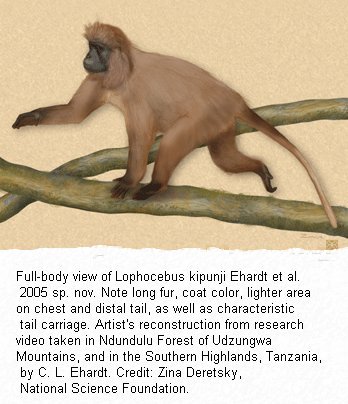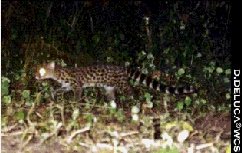|

il Centro
Tues 3rd Jan 2006
Field Research
In Africa on the Tracks of Kipunji[1]
A New Species of Monkey discovered by a Scientist Born in Abruzzo
It has been “baptised” Highland Mangabey and it is a new species of monkey that
has been discovered on an isolated mountain in Tanzania in Africa. The discovery
is exceptional and was made at least 20 years after the last discovery of a
monkey in the black continent. The primate (Lophocebus Kipunji) lives on the
flanks of the Rungwe volcano 2961 metres high inside the Kitulo National Park.
This discovery was made by the Italian researcher, Daniela De Luca, born in Rome
of Abruzzan origin. Tanzania in Africa. The discovery
is exceptional and was made at least 20 years after the last discovery of a
monkey in the black continent. The primate (Lophocebus Kipunji) lives on the
flanks of the Rungwe volcano 2961 metres high inside the Kitulo National Park.
This discovery was made by the Italian researcher, Daniela De Luca, born in Rome
of Abruzzan origin.
In fact Daniela De Luca’s father is from Giulianova and her mother is from
Torricella Peligna and Daniela has lived in both these centres in Abruzzo.
The discovery took
place during a research project, carried out under the Wildlife Conservation
Society (WCS) in Tanzania by a team of researchers under the English scientist
Tim Davenport, director of the programme and husband of Daniela, together with
two Tanzanian researchers, Noah Mpunga and Sophy Machaga.[**]
“”Daniela De Luca explained, “The monkey[a] belongs to a very rare species which
is in serious danger of extinction with a population estimated at between 500
and 1,000 individuals who
live at a bout 2,450 metres above sea level on Mount Rungwe[b]. This primate,
90cm tall, has long brown hair, probably an adaptation to the cold climate[c].”
 This monkey had been known for a long time to the local population of hunters
and the discovery came as a result of their stories describing this animal;
after years of interviewing people in the villages surrounding Mount Rungwe,
with the help of Mpunga, who heard the first mention “of a very shy monkey,
called Kipunji by the local tribes.” This monkey had been known for a long time to the local population of hunters
and the discovery came as a result of their stories describing this animal;
after years of interviewing people in the villages surrounding Mount Rungwe,
with the help of Mpunga, who heard the first mention “of a very shy monkey,
called Kipunji by the local tribes.”
The small primate was seen by Daniela De Luca in May 2003, but for environmental
reasons she could not get close to it. “It was only in December of that
year,” the scientist explains, “that we were really able to observe them close
up in the Livingstone forest of Kitulo National Park, and that Tim Davenport was
able to recognise that they were a new species of monkey.” The discovery was
confirmed a little while later by another group of biologists who made the same
discovery independently about 350 kilometres away. In July 2004 the Mangabey was
found in the Ndundulu forest in the Udzungwa mountains by a team of scientists
from Georgia University, in a project also financed by the WCS, which recognised
that the primate belonged to a species not yet described.
Daniela De Luca’s group has now properly categorised the monkey (the Highland
Mangabey[d]) characterised by an erect crest of hair on its head, elongated
cheek whiskers, an off-white belly and tail, and its unusual call, termed a
“honk-bark” by these authors, which they managed to record. But Tim Davenport
expressed his concerns for the future of this species of monkey, “The illegal
tree-cutting activities in these forests portend an uncertain future for this
rare animal. We need to intervene quickly to save this natural heritage.”
Walter Teti.
INTERVIEW
I am in Love with these places. But my oasis is on the Maiella.
The zoologist: I am looking for a house in the Park in which to rest from the
exertions of my journeys.
Daniela De Luca is senior scientist for the conservation programme of the
Wildlife Conservation Society in the Southern Highlands of Tanzania and is
scientific adviser for the Southern Rift Programme in Tanzania, Malawi and
Mozambique. For her Laurea Thesis in biological sciences at the University La
Sapienza, Rome, she included a project on the Striped Mongoose of the Queen
Elizabeth National Park in Uganda, where she later returned to carry out studies
and research for her doctorate (Ph. D.) which was on ecological sciences, taken
at the University of London’s Institute of Zoology at the Zoological Society in
London.
The scientist, of Abruzzan origin, has also studied wild flamingos and horses in
France and has worked at the Centre for Environmental Education of Ventotene[2]
and on census projects for elephants in Uganda, where she directed a programme
of co-operation for conservation of carnivores, with assistants and graduates
from Tanzania.
In June 2002 her name appeared in the journals Airone and Corriere della Sera
and on a Television programme, “La macchina del tempo” (The Time Machine), for
her rediscovery of the Servaline Genet[3] in the Udzungawa National Park in
Tanzania.
Recently Daniela De Luca stayed for many days in the centres of the Val Pescara,
within the Maiella National Park. She visited Caramanico Terme, Sant’Eufemia a
Maiella, Abbateggio, Roccamorice, Bolognano, Musellaro and Tocco da Casuaria.
“I love these places, their environment and the suggestive panoramas of the
Park,” she said. “They give me that same peace and love for Nature as the
stupendous, indescribable African Parks. I would love to buy a small farmhouse
or a house on the green slopes of the Maiella in which to spend several months
each year, just enough time to draw up and collate up my writings after my
studies and research in the field in Africa. It is an alternative that I would
far prefer than going to do this work in Rome or London.”
“But to come to the Park would also provide me with a fascinating reason, it
would make me feel a part of it all” continued Daniela De Luca. “Accustomed as I
am to close contact with African fauna, I would love to meet the bears, wolves,
wild boar, deer and roebuck that live on the Maiella and the Morrone; just the
idea of staying in a place surrounded by these animals thrills me. I expect the
presence of these animals causes problems for the local people, but it is
important that we work out an equilibrium, find a way to live together with
them.”
Translator's Notes:
[1] Kipunji - The Highland Mangabey (Lophocebus kipunji) is a species of Old
World monkey that lives in the highland forests of Tanzania. Known locally as
the Kipunji, it was independently discovered by two separate teams of
researchers in December 2003 and July 2004, making it the first new African
monkey species discovered since the Sun-tailed Monkey in 1984.
Highland Mangabeys are about three feet long and have a long brown fur which
tufts out from the sides and tops of their heads. Their faces and eyelids are
uniformly black, characteristic of their genus, Lophocebus, as is their arboreal
nature. All Mangabey males emit a loud call to coordinate spacing between
different groups. The Highland Mangabey has a unique call, described as a
"honk-bark", which distinguishes it from its close relatives the Grey-cheeked
Mangabey and the Black Crested Mangabey, the calls of which are described as a
"whoop-gobble".
Perhaps fewer than 1,000 of the animals live in the highland Ndundulu Forest
Reserve, an unprotected forest adjacent to Udzungwa Mountains National Park, and
250 miles away on Mount Rungwe and in the adjacent Kitulo National Park. The
forest at Rungwe is highly degraded, and fragmentation of the remaining forest
threatens to split that population into three smaller populations. The Ndundulu
forest is in better shape, but the population there is smaller. The monkey will
likely be classified as a critically endangered species.
[**] for information about the discoverers, see :-"Saving
Wildlife"
[a] Summary of an article in SCIENCE – 20 May 2005:
Vol. 308. no. 5725, pp. 1161 - 1164
DOI: 10.1126/science.1109191
The Highland Mangabey Lophocebus kipunji: A New Species of African Monkey
Trevor Jones, Carolyn L. Ehardt, Thomas M. Butynski, Tim R. B. Davenport, Noah
E. Mpunga, Sophy J. Machaga, Daniela W. De Luca.
A distinct species of mangabey was independently found at two sites 370
kilometres apart in southern Tanzania (Mount Rungwe and Livingstone in the
Southern Highlands and Ndundulu in the Udzungwa Mountains). This new species is
described here and given the name "highland mangabey" Lophocebus kipunji sp. nov.
(new species) We place this monkey in Lophocebus, because it possesses
non-contrasting black eyelids and is arboreal. L. kipunji is distinguished from
other mangabeys by the colour of its pelage; long, upright crest; off-white tail
and ventrum; and loud call. This find has implications for primate evolution,
African biogeography, and forest conservation.
[b] Mount Rungwe – an old volcano 2,960 metres above sea level (third highest
mountain in Tanzania, East Africa).
Map showing Mount Rungwe

Site description: Mount Rungwe and its associated belt of forests dominates the
mountainous country north-west of Lake Nyasa, Tanzania. The impressive crater
lake of Ngozi lies 10 km north-west of Mount Rungwe, encircled by the Mporoto
Ridge Forest Reserve. To the east of Mount Rungwe is the Livingstone Forest
Reserve which cloaks the steep escarpment of the Lake Nyasa Trough, overlooking
Mwakalele town. Common trees in these mountain forests include Aphloia
theiformis, Ficalhoa laurifolia, Maesa lanceolata, Trichocladus ellipticus,
Albizia gummifera and Bersama abyssinica. There are extensive stands of bamboo
in some forests and a belt of heathland on Mount Rungwe above 2,600 m. Grassland
and forest-edge habitats within these Forest Reserves are becoming increasingly
important for threatened animals and birds as agriculture expands into marginal
areas. Rungwe Catchment Forest Reserve (CFR) is one of the largest forest areas
and there are about 10 other smaller reserves. The south-eastern slopes of these
mountains receive up to 3,000 mm of rainfall per annum, the highest in Tanzania.
The Southern Highlands comprise mountain ranges and volcanoes capped by
forest-grassland. They include the two highest peaks in southern Tanzania,
Mtorwi at 2,961m (9,712ft) and Mt Rungwe, just one metre lower. They have until
now, received very little conservation attention. This despite initial surveys
having revealed significant biodiversity and many different, rare and
restricted-range species. Many of the region's unique plateaux and mountains
were produced by Rift Valley faulting in the late Cretaceous. Subsequent
volcanism also deposited lava and ash, especially at the northern end of the
Lake Nyasa (Malawi) Trough. Whereas the Eastern Arcs derive moisture from the
Indian Ocean, the Southern Highlands receive all its rainfall from November to
April via convectional uplift from Lake Nyasa (Malawi). Mt Rungwe is a key
source of water for Tukuyu, as well as the rich and fertile agricultural valley
of Kyela. Whilst the region as a whole averages 1,500mm per annum, Kyela
averages 2,900mm, the highest in Tanzania. It is little surprise given the
magnitude of the Southern Highlands that they play a significant role in water
catchment. They serve five of the twelve main drainage basins in Tanzania. The
catchment values of the Highlands thus influence the livelihoods of a quarter of
the country's population. Forest integrity is thus particularly important.
Threats: Natural habitats in the Southern Highlands are severely threatened by
unsustainable land-use practices and resource exploitation. A volcanic history
has bestowed the area with rich and fertile soils and this, coupled with
abundant rains, means that the region is both productive and in parts, highly
populated. However, expanding human populations inevitably put pressure on local
grasslands and forests, which are being rapidly cleared for intensive commercial
agriculture. Declining forest cover poses serious threats to the region's water
supplies and unmanaged hunting has reduced mammalian populations. Management of
natural habitat is hampered by limited financial and technical resources, as
well as by a lack of outside appreciation of the area's ecological and
traditional values. Rivers are poisoned for fishing and the risks to human and
ecosystem health are considerable. Although the natural grassland is
fire-climax, excessive and unmanaged burning is also degrading the remaining
areas of indigenous habitat.
Conservation issues: There has been massive degradation of natural habitat,
perhaps one of the reasons why its wildlife is poorly known. The remaining
forests have a high water-catchment value. They suffer substantial problems of
fire, overgrazing, illegal timber removal and an ever increasing amount of
cultivation.
[c] Temperatures average 22 degrees C (max) and 10 degrees C (min), but from May
to July frosts are common on higher ground with temperatures dropping to - 7
degrees C on Kitulo Plateau and including Mount Rungwe.
[d] The monkey occurs as high as 2450 m (8,000 ft) in Kitulo and on Mt Rungwe,
where temperatures often fall below freezing; its long coat is probably an
adaptation to the cold.
[2] Ventotene - Ventotene is an island in the Tyrrhenian Sea, located on the
western margin of the continental shelf of the coast of Italy between Rome and
Naples, off the coast of Campania. It is the remains of an ancient volcano, and
is part of the Pontine Islands. In Roman times it was known as Pandataria and
Pandateria.
The island is elongated, with a length of 3 kilometres and a maximum width of
about 800 metres. Santo Stefano is located 2 kilometres to the west, and Ponza
is 40 kilometres to the east.
The island has 633 permanent residents, and had a prison that has been closed.
Best known as the island to which Emperor Tiberius banished his grand-niece
Agrippina the elder in 29 AD. She starved herself to death, but it seems equally
likely that she was starved on the orders of the emperor, in 33 AD. After her
son Gaius (better known as Caligula) became Emperor in 37 AD he went to
Pandataria to collect her remains and brought them back to Rome.
Bathymetric data indicates that Ventotene is the south-eastern flank of a
composite volcano, with a basal area of about 300 km2, rising more than 700 m
from the sea bottom.
[3] Servaline Genet – A WCS scientist, Daniela De Luca , working in
south-eastern Tanzania has rediscovered a carnivore that had been undetected f or
the last 70 years. Photographed by a camera trap on the eastern side of Udzungwa
Mountain National Park, the Lowe's Servaline Genet - a three-foot-long
relative of the mongoose family - was previously known only from a single skin
collected in 1932. or
the last 70 years. Photographed by a camera trap on the eastern side of Udzungwa
Mountain National Park, the Lowe's Servaline Genet - a three-foot-long
relative of the mongoose family - was previously known only from a single skin
collected in 1932.
"This is the first ever photograph of Lowe's Servaline Genet and confirms the
animal's existence after seventy years," said WCS researcher Daniela De Luca,
who was conducting a carnivore survey in the Udzungwa Mountains National Park
using remote camera traps. "We now hope to find out more about
the animal and thus help ensure its survival."
For full article see
African Predator
'Rediscovered' in Tanzania
Translation courtesy of
Dr. Marion Apley Porreca |